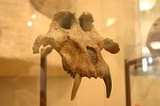
Theropithecus brumpti
Encyclopedia
Theropithecus brumpti is an extinct species of papionin
which lived in the mid to late Pliocene
.
This fossil
primate
is mostly known from skulls and mandibles found in Pliocene deposits excavated in the Shungura Formation
, at the Omo River
, Ethiopia
. T. brumpti, like its cousin the extant gelada
(T. gelada), is related to the baboon
.
monkey
, and like most other such animals was quadrupedal with highly dexterous, manipulative hands. Males grew very large, as a specimen found at Lomekwi, Kenya
is estimated to weigh approximately 43.8 kilograms. (In comparison, the male gelada averages around 20 kilograms ). The male was also most likely very colorful, with the female being smaller and less colorful, as the species displays a high degree of sexual dimorphism. Like most papionins, the male possessed large canine teeth, primarily for display.
. Large muscles in the long muzzle suggest that T. brumpti ate tough vegetation, and was capable of breaking and eating large nuts.
Papionini
Papionini is a tribe of Old World monkey that includes several large monkey species, including the macaques, baboons and the Mandrill.- Classification :* FAMILY CERCOPITHECIDAE** Subfamily Cercopithecinae*** Tribe Cercopithecini*** Tribe Papionini...
which lived in the mid to late Pliocene
Pliocene
The Pliocene Epoch is the period in the geologic timescale that extends from 5.332 million to 2.588 million years before present. It is the second and youngest epoch of the Neogene Period in the Cenozoic Era. The Pliocene follows the Miocene Epoch and is followed by the Pleistocene Epoch...
.
This fossil
Fossil
Fossils are the preserved remains or traces of animals , plants, and other organisms from the remote past...
primate
Primate
A primate is a mammal of the order Primates , which contains prosimians and simians. Primates arose from ancestors that lived in the trees of tropical forests; many primate characteristics represent adaptations to life in this challenging three-dimensional environment...
is mostly known from skulls and mandibles found in Pliocene deposits excavated in the Shungura Formation
Shungura Formation
The Shungura Formation is a palaeontological formation located in Ethiopia. It dates to the Pliocene - Lower Pleistocene period....
, at the Omo River
Omo River
The Omo River is an important river of southern Ethiopia. Its course is entirely contained within the boundaries of Ethiopia, and empties into Lake Turkana on the border with Kenya...
, Ethiopia
Ethiopia
Ethiopia , officially known as the Federal Democratic Republic of Ethiopia, is a country located in the Horn of Africa. It is the second-most populous nation in Africa, with over 82 million inhabitants, and the tenth-largest by area, occupying 1,100,000 km2...
. T. brumpti, like its cousin the extant gelada
Gelada
The gelada , sometimes called the gelada baboon, is a species of Old World monkey found only in the Ethiopian Highlands, with large populations in the Semien Mountains...
(T. gelada), is related to the baboon
Baboon
Baboons are African and Arabian Old World monkeys belonging to the genus Papio, part of the subfamily Cercopithecinae. There are five species, which are some of the largest non-hominoid members of the primate order; only the mandrill and the drill are larger...
.
Appearance
T. brumpti was a large terrestrialTerrestrial animal
Terrestrial animals are animals that live predominantly or entirely on land , as compared with aquatic animals, which live predominantly or entirely in the water , or amphibians, which rely on a combination of aquatic and terrestrial habitats...
monkey
Monkey
A monkey is a primate, either an Old World monkey or a New World monkey. There are about 260 known living species of monkey. Many are arboreal, although there are species that live primarily on the ground, such as baboons. Monkeys are generally considered to be intelligent. Unlike apes, monkeys...
, and like most other such animals was quadrupedal with highly dexterous, manipulative hands. Males grew very large, as a specimen found at Lomekwi, Kenya
Kenya
Kenya , officially known as the Republic of Kenya, is a country in East Africa that lies on the equator, with the Indian Ocean to its south-east...
is estimated to weigh approximately 43.8 kilograms. (In comparison, the male gelada averages around 20 kilograms ). The male was also most likely very colorful, with the female being smaller and less colorful, as the species displays a high degree of sexual dimorphism. Like most papionins, the male possessed large canine teeth, primarily for display.
Diet
T. brumpti was most likely a folivoreFolivore
In zoology, a folivore is a herbivore that specializes in eating leaves. Mature leaves contain a high proportion of hard-to-digest cellulose, less energy than other types of foods, and often toxic compounds. For this reason folivorous animals tend to have long digestive tracts and slow metabolisms....
. Large muscles in the long muzzle suggest that T. brumpti ate tough vegetation, and was capable of breaking and eating large nuts.

